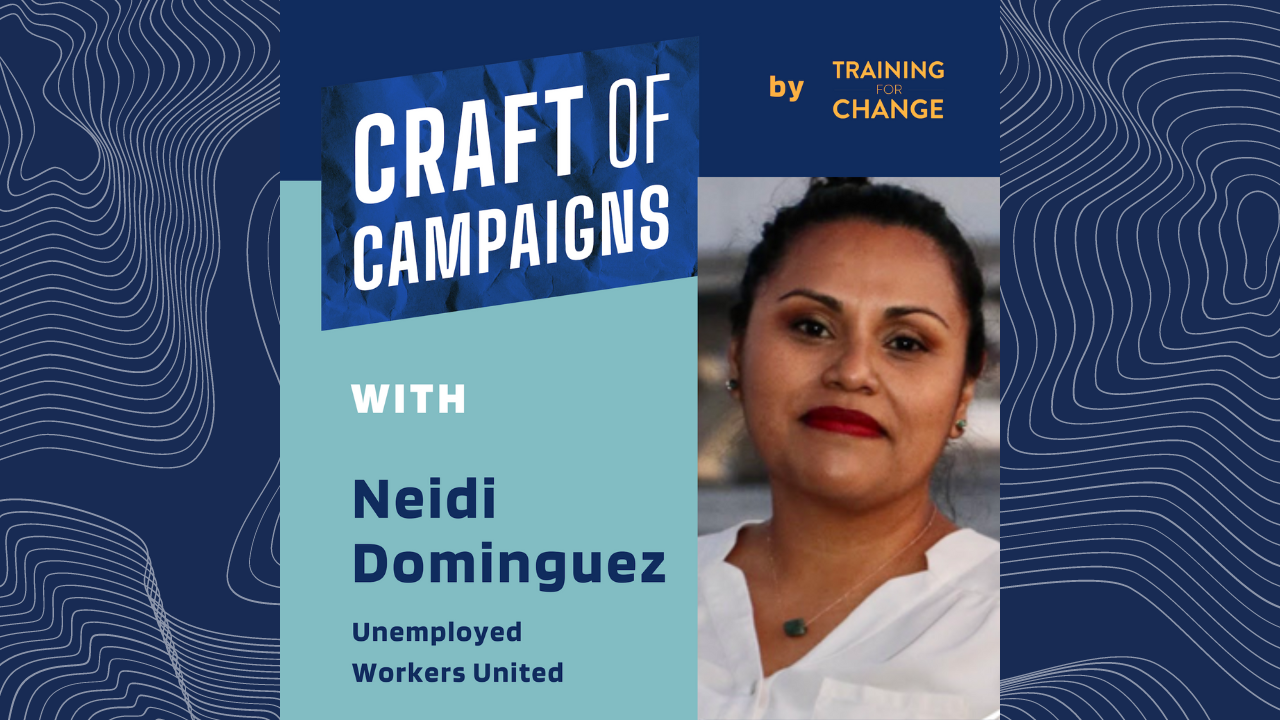The Craft of Campaigns podcast highlights stories and lessons from issue-based action campaigns, beyond one-off mobilizations and single election cycles. Campaigns channel grassroots energy to win concrete victories, build winning coalitions, and topple pillars of power standing in the way of justice. In each episode, we interview organizers about how a campaign unfolded, the strategy decisions they made, and the lessons we can draw for our current moment. You can read the writeup below or check out the full podcast here.
Ten years on from a historic victory that shielded one million immigrants from deportation, the story that gets re-told today, depending on who you’re listening to, is either: “Obama protected the Dreamers,” or “the immigrant rights movement pushed him to do the right thing.”
Neidi Dominguez, one of the many undocumented campaigners who were pivotal to the campaign’s success, reflects on the time between then and now differently: “The same DC advocates telling us we were crazy or that it was impossible are the ones picking up the mic ten years later telling everyone they have to protect DACA. Don’t believe them when they tell you what’s possible.”
Her story begins years earlier. The daughter of immigrant activists, Dominguez became a youth organizer at UC Santa Cruz, where she engaged in campaigns aimed at improving conditions for students and immigrant workers. Later, as a member of the undocumented youth organization the LA Dream Team, she recounts watching the fight for federal immigration reform from afar as “the DC organizations” focused on passage of a comprehensive bill by the full Congress.
In 2010, after three years of watching that strategy fail, “undocumented youth began to make our own calls on strategy.” They pushed forpassing the DREAM Act as a standalone bill, which they believed would pave the way for broader reform legislation. The LA Dream Team teamed up with undocumented organizers in other parts of the country — like Tania Unzueta in Chicago, who had organized the first “Coming Out of the Shadows” rallies — for sit-ins at congressional offices in DC and around the country.
Their efforts paid off: feeling pressure from the left, Senate Majority Leader Harry Reid committed to bringing the DREAM Act to a vote. When the bill failed, immigrant youth organizers once again split from DC-based groups, choosing to focus on winning presidential protection rather than continuing to push for congressional action. As Dominguez recalls, they were criticized by “the right, the middle, the left.” But those critics were missing the long game the younger organizers had planned out. “The whole point was to win protection for all. We figured, if we can get him to say we deserve protection, what argument could they use to deny our parents? We would go from DACA to DAPA.”
But even with broad alignment among younger undocumented organizers on the strategy and goal, there were disagreements. “Some of the most painful were about who were the right spokespeople. We have more language now to understand the made-up dichotomy about good immigrants versus bad immigrants’… We knew and felt that it was so wrong and unfair but didn’t have the political maturity to know at that moment that our movement was going to be so strong and able to withstand and be ok with having our friends who had been caught with a DUI be spokespeople,” she said.
Still, they didn’t let these internal tensions slow them down. Different formations “turned up” on the president throughout the year, chaining themselves to the White House gates and interrupting multiple appearances around the country while wearing shirts that read “Obama Deports Dreamers.” In August 2011, DHS announced a review of all cases currently in removal proceedings but failed to provide any permanent protection. That October, the LA Dream Team launched the Right to Dream Campaign with a civil disobedience at a Department of Homeland Security facility.
The Obama Administration argued that executive protection for Dreamers was unconstitutional. “So, we convened our own lawyers,” Dominguez recalls. In the process, they not only came up with their own legal arguments but also discovered that then-DHS attorney Alejandro Mayorkas had composed a memo about Obama’s executive powers as early as 2009. The memo revealed that the administration believed it could unilaterally grant relief from deportation, contradicting Obama’s insistence that only Congress had those powers. (Among their other research highlights: discovering that John Lennon had been granted deferred action from deportation!)
Other formations also turned up the heat. National Immigrant Youth Alliance affiliates began organizing sit-ins at Obama reelection campaign offices, prompting administration officials to look for dialogue with leaders like Dominguez.
In May, DHS invited attorneys working with the LA Dream Team to discuss their demands at the White House. But because Dominguez and other leaders insisted on coming, they had to meet at a rowhouse across the street; being undocumented, they wouldn’t pass the White House background check. “They thought it would just be attorneys talking to attorneys, but we had asked ours not to speak until we asked them to,” Dominguez recounts. They came armed with a letter signed by 96 law professors affirming the president’s power to grant deferred action and arranged for a news outlet to cover both the letter and the meeting. The group gave the administration two weeks to take action. A week later, other young immigrants started occupying Obama campaign offices. White House aides called Gaby Pacheco, one of the immigrant youth leaders who met with them earlier in May, asking, “‘What happened? You said we had two weeks!’ We said, ‘We told you we couldn’t control what would happen.’ It really put pressure on them,” Dominguez recalls.
Fifteen days after the meeting with White House officials, President Obama announced Deferred Action for Childhood Arrivals. “I’ll never forget it,” Dominguez says. “It was my mother’s birthday. We had 150 young people blocking a freeway exit as part of the DREAM Summer Internship with the LA Labor Center, and since 5am we had been getting texts telling us something was going to happen. We debated, ‘Should we go through with it?’ But I thought, ‘It’s not true until it’s true.'” Many undocumented organizers pivoted to demanding the administration expand protections to the other 11 million undocumented people living in the US. Two years later, in November 2014, Obama announced deferred action for parents (DAPA), though the executive action was eventually struck down by federal courts.
Youth organizers secured executive action to protect millions from deportation by bucking the mainstream consensus that a congressional act was the only path forward, and that go-slow, non-confrontational advocacy strategies were the best way to create the political will needed. They embraced multiple strategies across different formations, which sometimes created productive tension with their target, President Obama, and other times generated internal conflict. Dominguez credits their willingness to lean into disagreement with much of their success. “We consulted, sometimes hundreds of us, spending six hours together in a room. I will never forget the commitment and discipline that my peers and I had, that we took that as seriously as we did gave us so much grounding to make the decision together, even if we weren’t happy about it. I see less of that now.”
Listen in to my conversation with Dominguez to learn more about how immigrant youth organizers won legal protections through their ability to lean into disagreement, to align around a single demand, and to use an inside/outside strategy.

